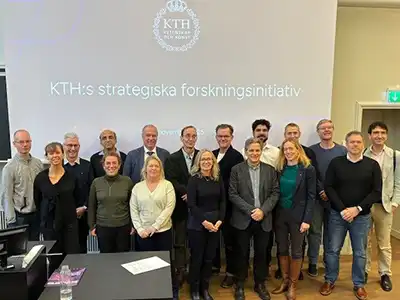A cavalcade of KTH research

KTH's strategic research initiatives, comprising 14 projects to date ranging from AI to new materials and smart urban development, were presented in an event attended by almost a full auditorium.
“It's fantastic to get an overview like this,” said Anders Söderholm, President of KTH, as he opened the meeting and provided background information on the initiatives.
He pointed out that many researchers face the reality of having insufficient time to write applications and lacking basic funding.
"At the same time, KTH's researchers are very good at attracting external funding. This is our biggest success factor, but it is also perhaps our biggest strategic challenge. We have to deal with a mosaic of highly competitive grants and a smaller amount of secure funding via basic grants," Söderholm said.
A start
This, together with the investigation conducted by Annika Borgenstam, Vice President for Research and Chair of the Research Committee, formed the basis for the establishment of the Research Committee in 2024 and the strategic research initiatives that came into effect just over a year ago.
The basic idea is that central funds should finance research initiatives aiming to attract significant external research funding, concentrating efforts in strategically important areas. This may involve strengthening an existing area or initiating something new.
“Initially, we planned to focus on a few initiatives, but then we decided it would be better to allow all the flowers to bloom,” said Annika Borgenstam.
Successful approach

This approach appears to have been successful: in both Vinnova's and the Swedish Research Council's major calls for proposals for clusters of excellence, several of KTH's strategic research initiatives have progressed beyond the first round of each call.
“Yes, that's very exciting. But I would just like to add that all the initiatives started at different times, are at different stages and have different-sized networks and different funding possibilities,” noted Annika Borgenstam.
All 14 projects presented have received one to two million Swedish kronor per year from KTH, which can be obtained for a maximum of five years. During the presentation, each research leader had five minutes to outline their strategic research initiative, covering the problem to be solved, the researchers involved, ongoing activities, and the financing strategy for the future.
Annika Borgenstam also took the opportunity to ask the researchers whether they felt the funding had made a difference:
“Yes, definitely. It has made a big difference, particularly when you have that as support going into other applications.,” replied Pär Olsson, who leads Nexus – the longest-running initiative – a view echoed by other researchers in the audience.
Text: Jill Klackenberg ( jillk@kth.se )
